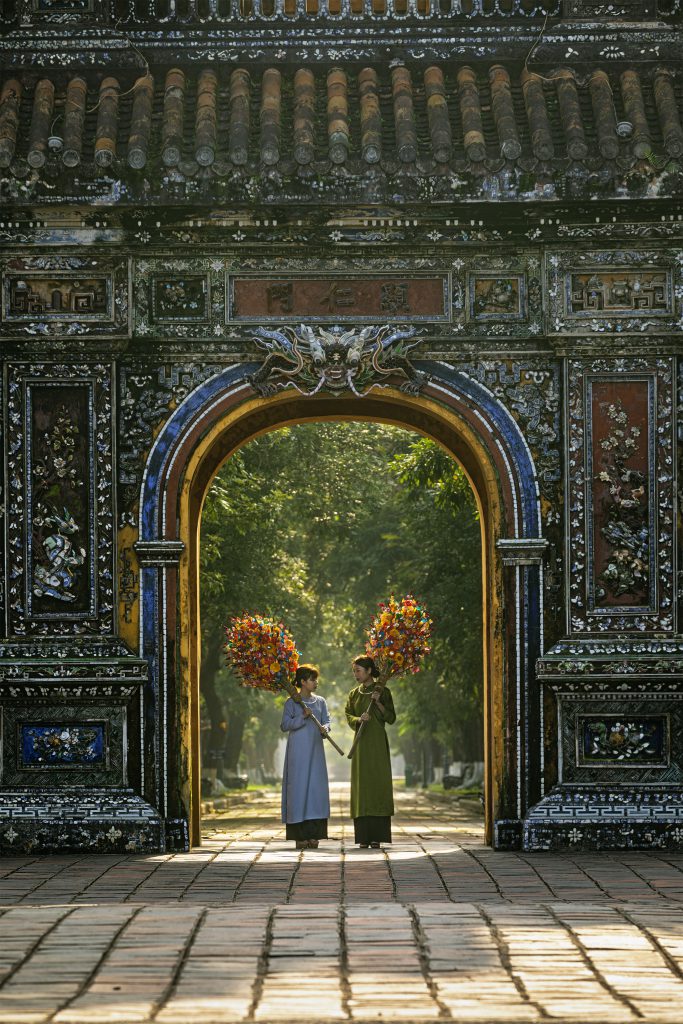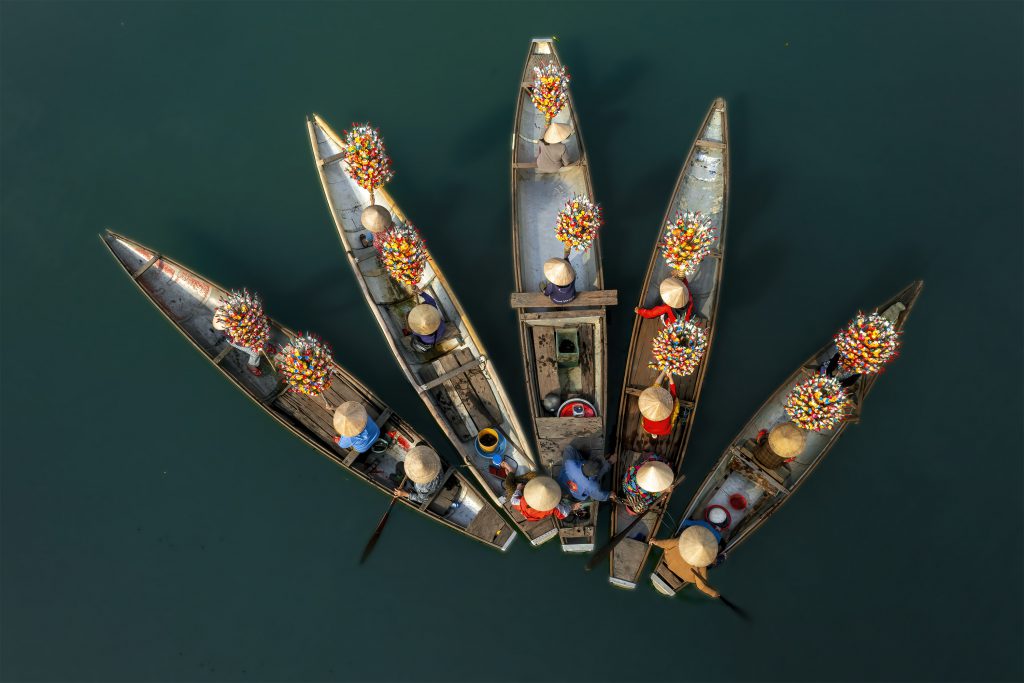Story: Nguyen Phuoc Bao Dan
Photos: Le Viet Khanh
Every year, before the return of spring, the streets of Hue grow more vibrant as vendors pass by selling beautiful paper flowers.
AN OLD VERSE EXPLAINS:
“Green, red, and yellow,
The whole village makes flowers every twelfth month.”
Every year, during the twelfth month of the lunar calendar, people in Thanh Tien Village put their field work aside to make paper flowers that will be used as offerings and decorations by residents of Hue and the surrounding areas. Thanh Tien Village currently has about 10 artisanal households that supply millions of mixed five-color paper flowers each year.

This village also held the secret to making lung flowers from the spongy white cores of the perennial lung plant (Bambusa longgissia). The artisan would roll the core of the plant in a spiral of concentric circles to make ivory-colored flowers before adding leaves made from green paper. These flowers were used to worship Trang Su (land genies). As well as making paper flowers, villagers in Thanh Tien also make dua (also known as roi flowers) from small bamboo sticks of about 15cm – 20cm long. One end of a stick is sharpened for secure planting and the other end is carefully whittled so that the bamboo fibers are not separated from the stick. This creates a sphere-shaped, multi-petaled flower on a stem shaped like a chopstick. These flowers are then sun-dried and dyed in five colors. Historically, Thanh Tien Village was once called Tan Lan or Tan Lang, mentioned in O Chau can luc (Recent Records of O Chau) collected and edited by Duong Van An in the mid-16th century. The village belonged to Mau Tai Tong (a former administrative unit), Phu Vang District, Trieu Phong Prefecture, which is modern-day Phu Mau Commune, Phu Vang District, Thua Thien Hue Province. The village is located downriver on the right bank of the Huong River, about 6 km northeast of Hue’s city center.

As far as Hue’s handicrafts go, Thanh Tien has been a household name for ages, alongside nearby villages like Hoai Tai, Mau Tai, Tien Non, and Lai An (Sinh Village). Many legends tell how Emperor Gia Long ordered each locality to offer a kind of precious flower to the capital. A courtier from Thanh Tien presented a branch of five-colored flowers from his homeland as a perfect symbol of the Three Fundamental Bonds and Five Constant Virtues. On a branch of Thanh Tien paper flowers, the three central largest flowers are made from gold-colored paper to represent the ruler as the Son of Heaven. They are symbolic of the Emperor – Teacher – Father. The five small flowers represent the virtues: Kindness – Decorum – Uprightness – Wisdom – Faithfulness. Because the meaning of the flowers is closely tied to monarchical Confucian schools of thought, the Emperor encouraged Thanh Tien’s villagers to promote their craft and make more products for the people of Hue.
Thanh Tien’s paper flowers are made from bamboo and five-colored paper. The crafting process is laborious and involves choosing old bamboo, splitting it, sharpening the bamboo sticks into stems, dying the paper, shaping the petals, and making the tang chan (pistil) from glassine or foil. Slowly, the paper plant begins to take shape beneath the gifted hands of Thanh Tien’s artisans. The blooms take many forms such as rambler roses, orchids, buds or clustered flowers, Cairo morning glory, and chrysanthemums.

After making the required number of flowers, Thanh Tien’s artisans wrap straw around bamboo sticks to make stakes to display the flower branches. These stakes are often transported by boat, bicycle, and motorbike, or simply on the shoulders of vendors who canvass every nook and cranny in the lead-up to Tet. People from and around Hue usually buy a few pairs of paper flowers to place on Bon Mang altars or in religious cubbyholes, or to use as offerings to kitchen gods and land genies. These flowers are displayed for the entire year. When the next Tet rolls around, they are removed from the altar, burned, and replaced with fresh branches.
THANH TIEN VILLAGE TODAY
After the ups and downs of history, Thanh Tien Village has been joined with nearby The Vinh Village to form the administrative division of Thanh Vinh Hamlet. However, the art of making paper flowers continues to be a distinguishing characteristic of this area.

Despite enduring many difficult periods, a few families in Thanh Tien remain bound to this craft. Artisans still making paper flowers include Than Van Huy, Nguyen Hoa, Nguyen Chi Khoan, and Nguyen Thi Thanh. With their dedicated and brilliant minds, they managed to recover the techniques for making paper lotus flowers, which were said to have been used for rituals at the Nguyen Dynasty royal court. Paper lotuses are now souvenirs commonly used as decorations. Young Hue residents, as well as tourists, also seek out these artisans to experience the craft, watch them work, or even try their hands at making paper flowers as gifts or mementos.
In discussions, besides imparting knowledge about dyeing flowers with natural leaves, bark, and roots, artisan Nguyen Hoa also shared: “Making paper flowers requires patience and fastidiousness because every branch is connected to our spiritual life. They may not emit aromas, but they have their own sacredness. Not only do paper flowers have a deep-rooted meaning in the spiritual lives of Hue people, but they are also heralds of the new year.”
In the lead-up to Tet, the bright colors of paper flowers help to chase away the gloom and chill of late winter. During this time, Hue’s Huong River seems to be painted in vibrant colors as flower-laden boats sail off in all directions from this downstream village.










